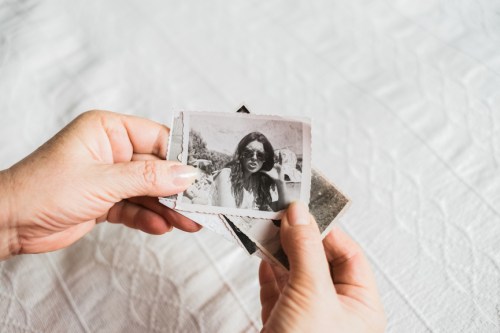Our editors independently select these products. Making a purchase through our links may earn Well+Good a commission
All day my parents have been screaming about how to organize old photos that have been avalanching in our garage and closet. My family lineage is built upon a love of photography, sentimentality, and hoarding, so we’re talking upon boxes and boxes upon boxes of black-and-whites, faded polaroids, a framed pin-up shot of my YiaYia for some reason. It’s an exhausting process that needs a lotta hand-holding, but if you also have an overload of photos, now’s a great time to go through them.
Why? Well, if you’re feeling distraught and claustrophobic during this time, the power of nostalgia is a natural way to lift your mood. But more than that, giving a sense of order and a place to access those feel-good memories allows us to feel in control and soothed all at once.
“In times of rapid unexpected change or stressful chaos, having an orderly place is comforting, as it reminds us that we can remain together despite the turmoil we sense around us,” says licensed psychologist Krystine I. Batcho, PhD. “It demonstrates that we have an active role in interpreting the meaning and purpose of our lives. Our life experiences aren’t random, we played a role in them, and often learned lessons from events. We then folded what we’ve learned into our ongoing lives and into our sense of who we are and who we want to be.”
All this, and in the most practical way, organizing your photos will just make them easier to access and share with the people we care about. But of course, dealing with nostalgia can be a taxing process at first, especially when you might need to get rid of clutter.
How to organize old photos
The reason my dad, or anyone, has a hard time organizing our old photos doesn’t just have to do with the avalanche. It has to do with the sometimes painful act of parting with memories and, sometimes, people. That’s why if you’re going through a mass home decluttering project, this is what you should do last.
“Organizing photos, or any sentimental object can be overwhelming because of the emotional content involved in organizing this category,” says organizational expert Patty Morrissey. “In the KonMari Method we encourage people to build their joy-checking muscle by working through other categories first. By the time they’re ready to tackle sentimental objects they have a lot more clarity around what’s worth keeping.”
Before you begin, there are a few resources that can help you you out. When it comes to tools you might need, Morrissey recommends having a magnifying glass can help you sort through slides (and/or recognize anything or anyone important). Using archival quality boxes like these ones from Kolo will help you store delicate photos easily. A service like LegacyBox can help you digitize anything that needs a technological afterlife. And if the whole things becomes too emotionally overwhelming, a service like the Photo Managers can give you that helping hand on how to organize old photos properly.
When you’re ready, here are four quick tips on organizing your photos appropriately and efficiently.
1. Clarify the “why” of why you’re doing this
According to Morrissey, how you go about the process will change slightly or significantly based on your goal. Do you want to make room? Do you want to capture and archive family stories? Are you making a special photo album or gift for a loved one? Or you just organizing these photos so they’re easier to access and enjoy?
2. Start with physical photos first, apply what you learn to your digital library
“Digital clutter can in some ways be more overwhelming than physical clutter,” says Morrissey. “Learn the fundamentals of organizing by going through the physical stuff in your life first, then apply those principles to your digital world.”
3. Get all of the photos in one place
This is to your longterm benefit. While it may feel overwhelming to have them all piled up at once, it’ll help you seek out duplicates, which are easy things to either toss or give away.
“It will be easier to discard photos when you realize you have many versions of the same photo than if you think you’re looking at the only one,” says Morrissey.
3. Sort chronologically, by person, or by theme.
Morrissey suggests empty shoe boxes, ziplock bags, file folders, literally whatever you have around the house that helps contain your photos works. Then you want to sort based on whatever your goal was.
For example, photo albums about certain family members calls for you to sort by person. Do you want to make a timeline of your life, or your family history? Do you want to make albums from your favorite trips, or family traditions? Sort by theme. Looking to make a timeline of something? You want to sort chronologically.
“I recommend bigger time chunks like decades instead of years to make sorting easier,” Morrisey says. “As you’re sorting, give yourself permission to toss any photos that are obvious discards; blurry thumb prints, endless duplicates, damage beyond repair,” Morrissey says.
4. Finally, sort into 3 subcategories, and put the winners into your album
- Discard: Photos you don’t want to keep for whatever reason. You don’t know anyone in the photo, the photo captures a particularly unflattering time in your life, whatever it is. Feel free to edit.
- Top 10%: these are the photos you’d frame or put in an album. The VIPs. They are great photos, artistically speaking, prompt a good story or special memory, remind you of the aesthetics of a time, or evoke a sense of place. You’ll feel it in your body more than you’ll know it in your mind. Trust that feeling.
- Everything Else: Photos that fall into the category of “aggressively fine.” Like, “Oh, this is a cute picture of me on the playground, just like the last 40 cute pictures of me on the playground, having helicopter parents is fun.” You don’t feel any huge draw to it, but again, it is fine.
Morrissey says that you’ll likely lean hard on the Everything Else category at first, because you might not be able to stomach throwing photos away. When you’re done sorting, she suggests to box these up, label by their category and don’t give them another thought.
“Over time, as you’re enjoying your Top 10%, you’ll likely let go of your attachment to the Everything Else group and will feel comfortable letting them go,” says Morrissey. “At family events, or when the time comes to pass photos down to the next generation, you’ll have a curated archive to share.”
Sign Up for Our Daily Newsletter
Get all the latest in wellness, trends, food, fitness, beauty, and more delivered right to your inbox.
Got it, you've been added to our email list.











